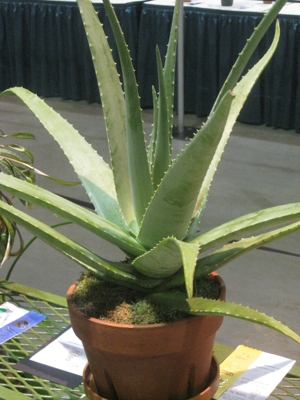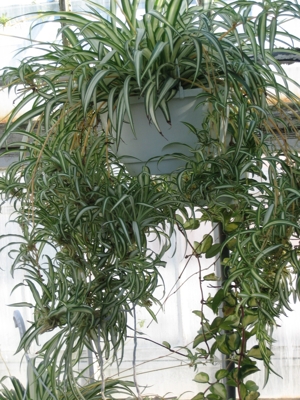Growing plants indoors has always been a popular hobby. Usually plants are grown for their natural beauty and decorative appeal. More recently scientists have discovered that certain houseplants can rid indoor air of several common household pollutants and toxins. Most people are aware that as plants photosynthesize they take in carbon dioxide and release oxygen. Studies show that plants are able to take in other gaseous pollutants as well.
Four of the most common indoor air pollutants found in homes and offices are formaldehyde, benzene, trichloroethylene and carbon monoxide. These are released from a variety of sources. Formaldehyde is found in particle board and pressed wood products used to make furniture, in carpets, permanent-press clothes, water repellents, flame retardants, many paper products, natural gas, kerosene and cigarette smoke. It may irritate the eyes, nose and throat, cause headaches and dermatitis, and may be connected to a rare type of lung cancer.
Benzene is present in many common household items like inks, oils, paints, plastics and rubber. It is contained in gasoline and is used in the manufacture of dyes, detergents and pharmaceuticals. Benzene exposure can lead to skin and eye irritations, headaches, loss of appetite, psychological disturbances and blood diseases. Some tests have indicated that benzene has carcinogenic and mutagenic properties.
Trichloroethylene is most often used for industrial purposes but can be found in printing inks, paints, varnishes and adhesives. It is considered a potent liver carcinogen. Carbon monoxide occurs whenever combustion does, be it from a cigarette, automobile or furnace.
Since many people spend a large amount of time indoors, especially during the winter months, it makes sense to minimize any negative health risks associated with indoor air quality. This has become more of a concern in recent decades because of two factors. Homes and office buildings are built to conserve energy through tighter construction methods and increased insulation. This keeps warm air from the furnace and cool air from the air conditioner inside but also blocks the escape of potentially harmful indoor air pollutants. Older, leaky buildings have fewer indoor air quality concerns. Compounding this effort is the fact that many household items are the result of man-made processes. In years past, one would find wool rugs and wooden spoons. Now the rug fibers are synthetic and plastic abounds.
Scientists at NASA were interested in the effects common houseplants had on indoor air quality because they were studying ways to purify the air in future space stations. In the late 1980’s, scientists at NASA designed experiments to examine the impact 19 common houseplants had on 3 ubiquitous indoor air pollutants. The study found that all 19 of the houseplants can remove some of the pollutants but certain plants were more efficient at removing specific pollutants than others. For instance, the Warneck dracaena removed 50 percent of the formaldehyde but only 10 percent of the trichloroethylene over a 24-hour period from a sealed chamber. A chrysanthemum removed 41.2 percent trichloroethylene and 61 percent formaldehyde in the same experiment.
An interesting outcome of the study was that a plant’s roots and its potting soil were also important contributors to the plant’s air purifying system. Data from a separate 2 year NASA study showed that when the same plants and potting soil were continuously exposed to air containing pollutants like benzene, their capacity to clean the air improved over time. This suggests adaptive abilities on the part of soil microorganisms.
Houseplant that Improve Indoor Air Quality
| Common Name | Scientific Name | Properties |
| Bamboo palm | Chamaedorea sefritzii | Improves air quality |
| Banana | Musa oriana | Improves air quality |
| Boston fern | Nephrolepsis exalta | |
| Bromeliads | Bromeliaceae | Improves air quality, emits oxygen at night |
| Chinese evergreen | Aglaonema modestum | Improves air quality |
| Christmas cactus | Schlumbergera | Emits oxygen at night |
| Dracaena-cornstalk | Dracaena fragrans ‘Massangeana’ | Improves air quality |
| Dracaena-Janet Craig | Dracaena deremensis ‘Janet Craig’ | Improves air quality |
| Dracaena-Red-edged | Dracaena marginata | Improves air quality |
| Dracaena-warneck | Dracaena deremensis ‘Warneckei’ | Improves air quality |
| English ivy | Hedera helix | Improves air quality |
| Florist's daisy/mum | Dendranthema morifolium | Improves air quality |
| Gerbera daisy | Gerbera jamesonii | Emits oxygen at night |
| Golden pothos | Epipiremnum aureum | Improves air quality |
| Holy basil/Tulsi | Ocinum tenuiflorum | Emits oxygen at night |
| Mother-in-law’s tongue/Snakeplant | Sansevieria trifasciata ‘Laurentii’ | Improves air quality, emits oxygen at night |
| Orchids | Orchidaceae | Emits oxygen at night |
| Palms | Areca | Emits oxygen at night |
| Peace lily | Spathiphyllum ‘Mauna Loa’ | Improves air quality |
| Philodendron-Elephant ear | Philodendron domesticum | Improves air quality |
| Philodendron-Heart leaf | Philodendron scandens ‘Oxycardium’ | Improves air quality |
| Philodendron-Lacy tree | Philodendron selloum | Improves air quality |
| Spider plant | Chlorophytum comosum | Improves air quality |
| Weeping fig | Ficus benjamina | Improves air quality |
| ZZ Plant | Zamioculcas zamiifolia | Removes volatile organic compounds |

Aloe

Spider plant
Most likely, many if not all houseplants can reduce indoor air pollutants. Select plants that have cultural requirements similar to the environmental conditions they will be placed in. Consider factors such as light intensity, temperature, humidity, and exposure to heat sources or drafts.
Healthy plants will do a better job purifying the air than those struggling to survive. Keep your plants thriving with proper light and watering, fertilizing, repotting and pest control. Since the plant’s leaves play a major role in air purification, keep them clean by wiping with a damp cloth or occasionally spraying down the foliage in the sink or tub. NASA recommends one healthy plant in a 6 to 8-inch container for every 100 square feet of living space.
References:
Wolverton, B. C., Johnson, A., and Bounds, K. 1989. Interior Landscape Plants for Indoor Air Pollution Abatement. National Aeronautics and Space Administration, John C. Stennis Space Center. MS 39529-6000
Brown, D. L. 1999. Houseplants Help Clean Indoor Air. University of Minnesota Extension Service Fact Sheet. H110
Despite good cultural practices, pests and diseases at times may appear. Chemical control should be used only after all other methods have failed. For pesticide information please call UConn Home and Garden Education Center or your local cooperative extension office.
The UConn Home & Garden Education Center supports UConn Extension’s mission by providing answers you can trust with research-based information and resources. For gardening questions, contact us toll-free at (877) 486-6271, visit our website at homegarden.cahnr.uconn.edu, or reach out to your local UConn Extension center at extension.uconn.edu/locations
Dawn Pettinelli, UConn Home & Garden Education Center, 2009